Cabinet for gas cylinders: requirements for storing cylinders + tips for choosing and installing a cabinet
From the moment of its creation and with the further development of the gas industry, its main direction is considered to be complete gas supply to all residents of the country. Therefore, the construction of main gas pipelines is carried out so that the maximum number of consumers can be supplied with gas.
And although the gasification process has been going on for decades, in remote settlements on the outskirts of the country, as well as in small holiday villages and suburbs, there is still no centralized gas supply. This is why many owners of gas equipment have to use gas cylinders. But how to store them correctly and is it necessary to buy a cabinet for gas cylinders?
This is exactly what we will talk about in our article - we will consider the most pressing issues regarding the safe maintenance of gas cylinders at home, legal requirements and optimal solutions for the use of special cabinets.
The content of the article:
How to store gas cylinders
While providing convenience and comfort in the home, gas is nevertheless particularly dangerous. Cases are not uncommon domestic gas explosion And cylinders due to the fault of users. Therefore, the operation of household gas cylinders must be carried out in accordance with safety requirements.
In the legislation of the Russian Federation, the procedure for transportation, storage and safe operation is regulated by a number of regulations. So, RF PP N 410 dated May 14, 2013concerns measures to ensure safety when using and maintaining gas equipment. Its provisions regulate the use of gas in household cylinders and oblige the use of only serviceable cylinders that have not expired.
Moreover, the owners themselves are obliged to monitor the condition, timely repair and maintenance of containers with liquefied household gas, without interfering with the conduct of scheduled maintenance by representatives gas company.
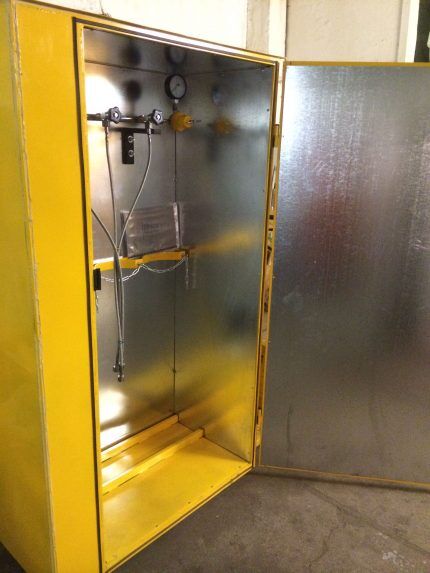
Rules for operation, maintenance, repair and cylinder refills registered in Resolution No. 91 dated June 11, 2003.
It is also stated here that the standard service life of pressure vessels, which include cylinders with liquefied household gas, is determined by the manufacturer. And after the expiration of its service life, such a cylinder is prohibited from being used.
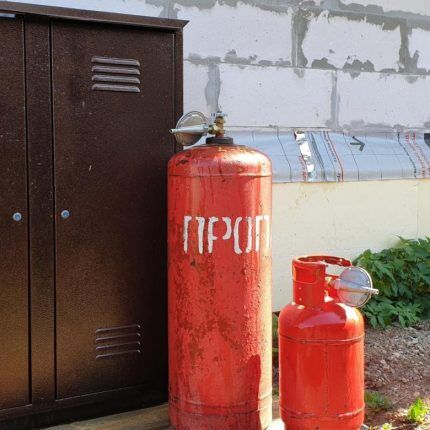
The legislation also provides for the procedure for storing gas cylinders. Requirements of Article 92 RF PP N 390 dated 04/25/2012 “On the fire safety regime” states: cylinders for household gas appliances with a volume of more than 5 liters should be located in cabinets made of non-combustible materials near a blank wall partition.
Thus, a cabinet for cylinders is a mandatory attribute that must be made in accordance with Article 93 of this resolution.
Cabinet design and installation
As mentioned above, the use of cabinets for storing gas cylinders is a mandatory condition for their operation in accordance with the law of the Russian Federation.
The main criteria that all gas cylinder cabinets must meet are:
- be made of non-combustible materials (both the body and all components);
- be locked;
- have special blinds for ventilation;
- on the surface have warning signs “Flammable. Gas".
Due to their properties, the non-flammable materials used to make the cabinet not only do not ignite, they also do not smolder and do not allow fire to spread. This creates high fire safety against the risk of fire or explosion.
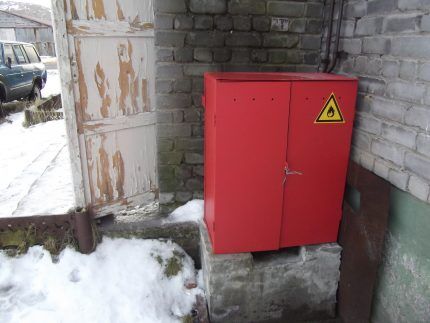
Metal is considered a reliable material from a fire safety point of view. It is from this that special cabinets are made - storages for gas cylinders. They are designed taking into account all the necessary conditions for connecting a gas cylinder.
Cylinder cabinet design
Any metal cabinet for household gas cylinders consists of the following components:
- outer casing, made of steel sheets with a thickness of at least 1 mm;
- door - single-leaf or double-leaf;
- internal tray for cylinders - it can be solid or made in the form of a lattice;
- stationary cylinder mount — a special mount, which is located inside the cabinet and serves to securely hold the cylinder inside;
- holes on the back wall For gas hoses;
- ventilation holes — they are made regardless of whether the internal tray is a solid one or made in the form of a lattice;
- metal handles and latches on cabinet doors;
- fastenings to be able to attach a padlock.
It is important that the handles and latches on the doors should also be made of fire-resistant material. It is not allowed to make latch handles from plastic.
Often cabinets are made in one piece, but there are options in the form of an assembled structure. The cabinet is completely covered with polymer paint (epoxy-polyester paint, which is most often called powder paint). It is fire resistant and protects the cabinet from corrosion.
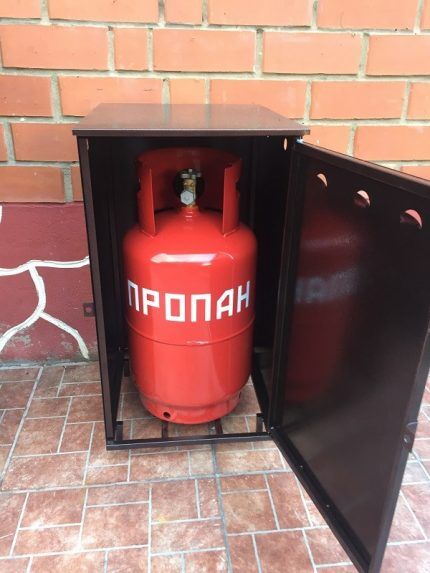
Where can I place a cabinet with cylinders?
It is strictly not recommended to install gas cylinders in storage rooms.
The legislation does not prohibit, as a last resort, placing a cylinder, connected to the stove or other gas-using equipment in the kitchen, subject to two conditions:
- ceiling height must be at least 2.2 meters;
- presence of a window for ventilation.
When using a gas cylinder in the kitchen, it is important not to remodel the room, in particular to combine the kitchen with a balcony, removing doors and windows. This is prohibited by law.
General rules for using gas cylinders indoors:
- cylinder volume up to 5 l;
- a distance of at least half a meter to a meter from the stove (place with an open fire) and at least a meter from heating devices;
- should not be installed next to a window;
- distance from the front door of at least 10 cm;
- the wall should not be made of flammable materials;
- It is necessary to provide free access to the places where gas hoses are attached.
When installing a cabinet for a gas cylinder on the street, choose stationary products that can be securely fixed to one of the walls of the building. In internal non-residential premises (outbuildings) portable cabinets are usually used.
General rules for installing cabinets for storing household gas cylinders:
- the side of the house is selected with priority to the least exposure to sunlight;
- the side to which the cabinet is adjacent must be made of non-combustible materials;
- at least 5 meters from the entrance to the house or descent to the basement;
- presence of a foundation of at least 10 centimeters;
- free access to gas hose mounting points.
It is important that when installing in extensions or outdoors, grounding must be provided, which will eliminate the possible occurrence of static voltage.
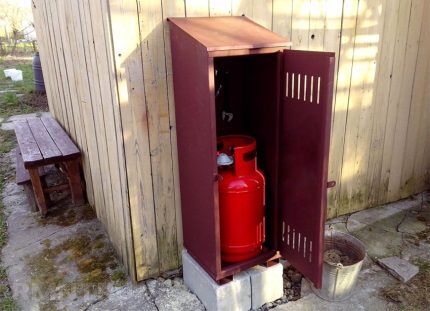
According to Art. 91 RF PP N 390 storage of gas cylinders is not allowed:
- in living rooms and premises;
- in basements and basements;
- in rooms without natural light.
It is worth ensuring that the place where the cabinet is installed is not a walk-through area. This will reduce the risk of causing any mechanical damage to the cabinet surface.
For installation, a set of fasteners is used, which ensures adhesion of the cabinet to the surface and guarantees stability during use.
Recommendations for choosing a cabinet
The choice of cabinet depends on the volume of the gas cylinder. Depending on the purpose of use, 5 l, 12 l, 27 l, and 40 l cylinders are used for household gas. And 50 l.
If gas will be used only for cooking, small-capacity options are suitable. If gas is also needed for autonomous heating, then you should pay attention to large volumes.
Also, the size of the cabinet depends on the number of cylinders. Often several gas cylinders are used: a main one and a spare one. This is convenient in winter, when the gas supply of the main cylinder runs out, and you only need to switch the gas supply to the spare cylinder. It is possible to arrange both the cylinders together in the cabinet and separated by a partition.

When choosing, it is also useful to evaluate the dimensions of the building in which the cabinet will be installed. After its installation, there should be free space for the owner to move comfortably.
Making your own cabinet
The cost of cabinets for gas cylinders starts from 2500 rubles. If you have certain skills and follow a number of rules, you can make and assemble a similar product with your own hands.
Algorithm of actions before starting work:
- decide on the type of design of the future cabinet, calculate the number of gas containers included in it;
- make a drawing defining the cabinet parameters - height, width, depth;
- select the required material – high-quality steel.
It is worth paying attention to careful preparation for work; the further correct implementation of the cabinet for the gas cylinder depends on this.
Algorithm of actions for direct assembly of the cabinet:
- assembling a frame from metal corners;
- creating a tray for cylinders;
- covering the frame with metal sheets;
- making a hole for the hose in the back or side of the cabinet;
- making holes for ventilation with a diameter of 1 cm with a distance between them of 7-8 cm - the number of holes on one side is at least 16;
- making fasteners for cylinders - it is allowed to fasten cylinders with a chain, and the chain links must be tightly stretched;
- installation of door hinges and padlock structures.
When assembling the cabinet, you can use a welding machine if you have the appropriate skills performing welding work.
If the cabinet is planned to be used inside a building, then it is necessary to consider the presence of legs with a height of at least 10 cm.
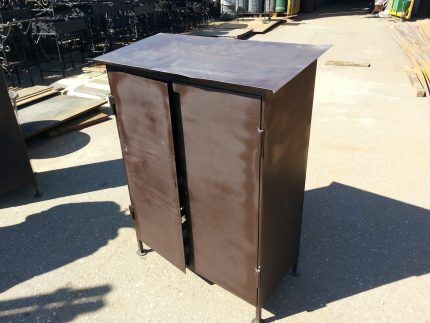
The final stage is coating the entire structure with polymer paint. After complete drying, all that remains is to install the cabinet in the chosen location and securely fasten it.
Conclusions and useful video on the topic
For a visual representation of cabinets for gas cylinders and the order of its assembly, it is worth watching the video presented below.
This video shows how to properly install and use the gas cylinder cabinet:
This video shows the self-assembly of a cabinet for a gas cylinder:
Regardless of the purpose for which a gas cylinder is used, you must always remember safety. That is why the presence of metal cabinets is considered a prerequisite, which will prevent ultraviolet radiation from entering the cylinders, causing mechanical damage and protecting them from the consequences of an explosion.
Would you like to supplement the above material with useful information and recommendations for the storage and operation of household gas cylinders? Or do you still have questions that we did not address in this article? Ask them to our experts and other site visitors in the comments section.



